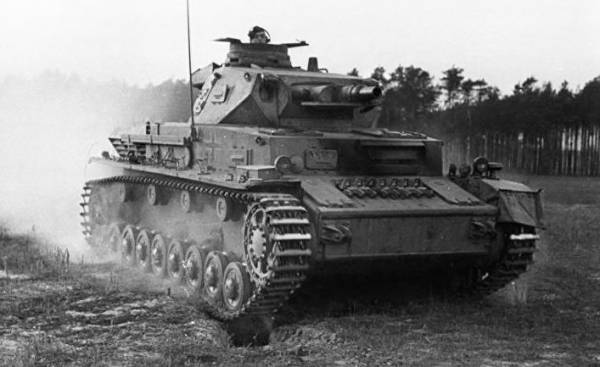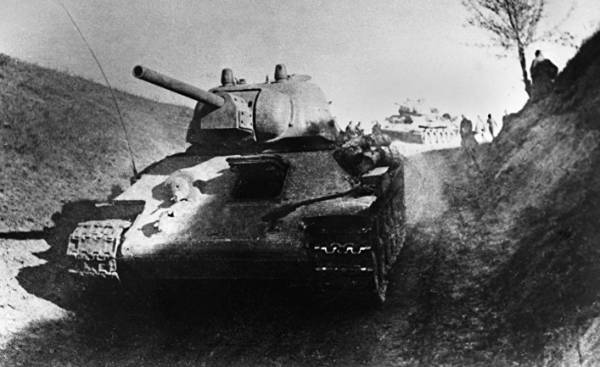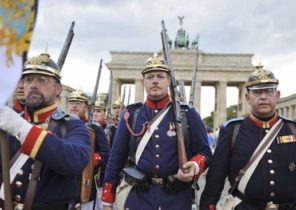
Less is more — at least sometimes. Lower caliber do can sometimes be more effective caliber — even if at first glance such a statement seems paradoxical.
On the threshold of 1942, German designers of armored vehicles were under tremendous pressure. Over the past few months they have significantly improved the modification of existing German tanks T-4, bringing the thickness of the lower frontal plate up to 50mm, and also equip the machine additional end plates with a thickness of 30mm.
In connection with the increased for 10% by mass of the tank, now amounting to 22.3 tons, needed to increase the track width of from 380 to 400mm. It was necessary to make changes in the design of rails and wheels. In the automotive industry such improvements like to call a change in the model — in the case of T-4, revision designation changed from “E” to “F”.
However, these improvements were not sufficient for conversion of T-4 into a full-fledged opponent of the Soviet T-34. First of all, the weak point of these machines was their weapons. Along with the 8.8 cm anti-aircraft gun and cannons captured from the reserves of the red army — 76mm guns, which the Germans called “Rach-boom” in the summer and autumn seasons its effectiveness, among other things, proved antitank gun 5cm Pak 38, as carried out shots heavy shells with a tungsten core.
The problems the leadership of the Wehrmacht was well known. At the end of may 1941, before the attack on the Soviet Union, discussed the urgent equipping of the T-4 gun Pak 38, just two-thirds, reducing its caliber, which was to replace the short 75-mm tank gun KwK 37, which bore the name “Stummel” (Rus. a cigarette butt).
Because of the length of the gun is 1.8 m heavy shells it was impossible to give sufficient acceleration, because their initial velocity was only 400-450 m/S. Pak 38 Shells, despite the fact that the caliber of the gun was only 5cm, at the exit of the nozzle reached a speed of 800 m/s, and after almost 1200 m/s.
In mid-November 1941 was supposed to be ready the first prototype of the T-4 with a gun Pak 38. However, shortly before it was found that the envisaged modification of the T-4, which was considered a temporary solution on the way to creating a tank, able to withstand the T-34, can’t be realized: Germany had an insufficient amount of tungsten to begin mass production of heavy shells.
November 14, 1941 at the headquarters of the Fuehrer held a meeting, which cost the German engineers peaceful Christmas. Because Hitler has decreed that as soon as possible to completely reorganize the production of armoured vehicles. From now on, provided only the production of four types of vehicles: light reconnaissance tanks, medium battle tanks on the basis of previous T-4, new heavy tanks, is ordered for production in late June 1941, T-4 “Tiger” and additional “hardest” tanks.
Four days later the order was given to develop a new 7.5 cm gun, the barrel of which was lengthened from 1.8 m to 3.2 m and which was to serve as a substitute for “Stummel”. Initial velocity of the projectile increased from 450 to 900 m/s, and that was enough to destroy any T-34 from a distance of 1000-1500m, even using explosive shells.
However, had the spot and tactical changes. Still tanks T-3 was the basis of military equipment German Panzer divisions. They had to fight with enemy tanks, while heavier tanks T-4 was originally designed as an auxiliary machine for destroying targets which could not handle guns of small caliber. However, even in the battles against French tanks revealed that a serious opponent could be the only T-4.
Every German tank regiment nominally had 60 tanks T-3 and 48 tanks T-4 and other crawler machines easier design, part of which was made in the Czech Republic. In fact, however, on the Eastern front on 1 July 1941 at the disposal of the 19 who fought the Panzer divisions were only 551 T-4. Despite the fact that a continuous supply of troops with armored vehicles in the amount of about 40 cars per month were carried out with plants in Germany for three groups of armies involved in the fighting in the Soviet Union, because of war-related supply disruptions by the spring of 1942 the number of tanks grew only to 552.
However, by the decision of the Hitler T-4, formerly the auxiliary machines, was supposed to be the main combat vehicles of armored divisions. It touched and subsequent modification of German military machines, who was at that time under development, namely, T-5, known as “Panther”.
 © RIA Novosti RIA Novosti | go to fotomontajes T-34 tanks during the attack on the right Bank of the Dnieper
© RIA Novosti RIA Novosti | go to fotomontajes T-34 tanks during the attack on the right Bank of the Dnieper
This model, to develop which started in 1937, 25 November 1941 were given to the trade and managed to acquire experience of the confrontation of the T-34. It was the first German tank, whose front and side armor plates were installed at an angle. However, it was clear that the supply tanks of this model in a more or less sufficient quantity could be implemented no earlier than 1943.
Meanwhile, tanks T-4 had to cope with a role of main combat vehicles. Engineers involved in the development of armored vehicles companies, first of all, Krupp in Essen, and Steyr-Puch in Sankt Valentin (lower Austria) for the new year managed to increase production and at the same time, refocus it on the launch of the F2 equipped with an extra long cannon Kwk 40 shipped for the front in March 1942. Earlier, in January, 1942, issue 59 T-4 for the month exceeded the established norm in 57 tanks.
So, T-4 tanks to artillery for approximately on par with T-34 tanks, but still inferior to the powerful Soviet machines in mobility. But more important was the lack of other available — number of vehicles produced. For the whole 1942 year produced 964 T-4, and a long gun was equipped with only half of them, while T-34 produced more than 12 thousand cars. And here, even the new guns nothing could change that.







